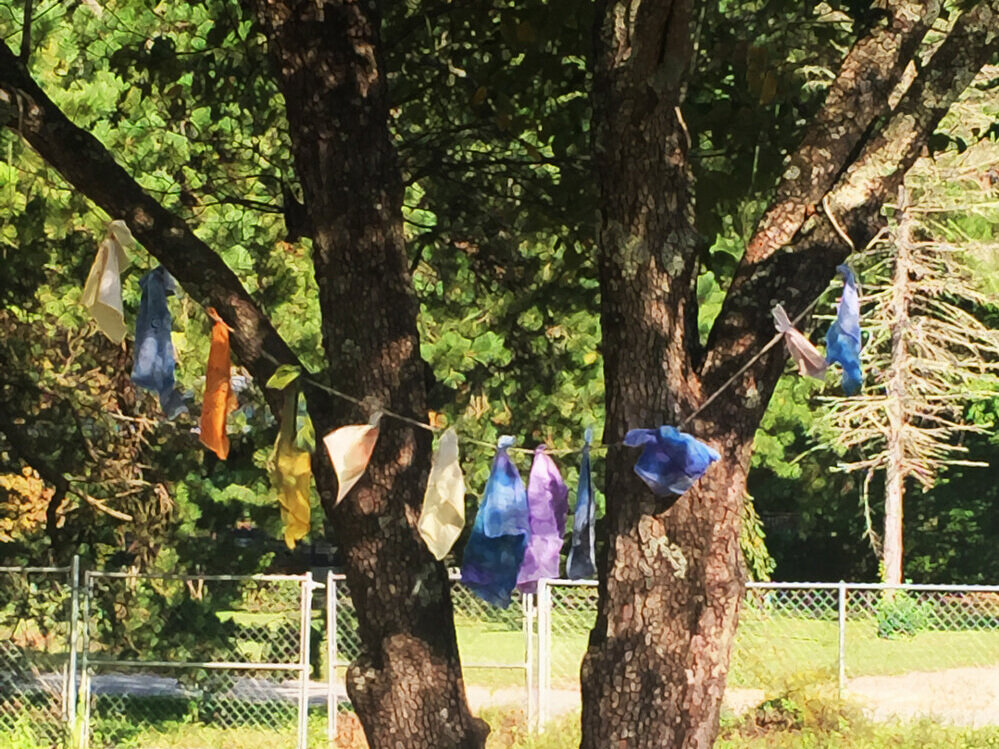Making Prayer Flags
Saturday was the Grand Opening of The Center Within in Black Mountain. The Center’s practitioners shared a bounty of free offerings, but it was the joyous participation of the community that made it a celebration.
Participation is a major theme in my work. Barfield has defined participation as “of self and not-self identified in the same moment of experience,” an experience more often characteristic of indigenous peoples, while the dominant western experience is characterized by a perception of subject-object split. The belief that we are somehow strictly separate from the world around us seems, when you think about it, ludicrous. Native American scholar Vine Deloria asks, “What has happened to Western civilization to move it away from a more unmediated natural life and into the callous, restrictive perspectives it presently takes as natural?” Western culture, (now, global culture) is made of peoples who are uprooted from ancestral homelands, whether by choice, by catastrophe, or by force: that is, peoples who are no longer indigenous. This physical detachment has developed into a widespread insensitivity that threatens us all. It is urgent that we move towards healing our split. But how?
The creative process is one road to participation. To interact and communicate with various aspects of self and world, and to explore the unknown, we can use expressive arts—that is creative expression—in tandem with archetypal psychology and meditative awareness. Following the creative impulse leads to personal discovery, and opens the door to intuitive communication.
Prayer Flags and Participation
Prayer flags demonstrate belief in the idea of participation: that we are a part of the world that holds us; that our actions—including our intentions—have effects; and that there are simple ways for us to communicate with the trans-human world.
Prayer flags use tangible forms to interact with the intangible. Similar practices are found across indigenous traditions. I will mention three: Tibetan, Siberian, and Celtic.
The familiar Tibetan prayer flags use five colors, blue, white, red, green, yellow, repeated in a certain order along a string. The colors are associated with the five elements and five directions, and each carries a world of symbolism extending from these. Prayers, mantras, and symbols are inscribed on the flags: good intentions to be carried on, around the world, by the wind and the rain.
The Siberian tradition of a Prayer Tree holds the tree as sacred bridge between heaven and earth. Community members make offerings of food and drink to the Prayer Tree, and ribbons holding prayers are tied loosely to branches. The local shaman offers chants of thanks to helpful spirits for carrying the prayers to the heavens for the benefit of the people.
In the Celtic tradition, cloutie wells are sacred springs, usually next to a tree (clouties are rags). The rags are often dipped in the water and then tied to the tree with a prayer for healing. As the rag disintegrates, so does the misfortune.
Here and Now
We can respectfully follow the examples of other cultures, yet integrate our own experiences and beliefs into the tradition, incorporating symbols and practices that we find meaningful. We can begin with clarifying our intentions: for the well-being of others; for communicating with the spirit world, or with the world at large; for healing or the release of misfortune. Be mindful, don’t rush, and know that you can carry out this very simple yet powerful ritual anywhere, anytime.
Begin with attunement. Breathe. Quiet yourself. Become clear on the intention, blessing, or prayer you would like to send to the world. As you feel ready to begin, begin…. Take a ribbon or strip of cloth, and simply, mindfully, sit with it, pray into it, and then place it on a tree. Or, work into paper or cloth, adding symbols, words, feelings. Several can be attached together with string or yarn.
Be clear in your mind what your intention is, and keep your focus on this intention as you work, and continuing as you place the prayer flag on the tree, or wherever you will place it, with reverence, kindness and intention.
Making Prayer Flags: Mythos-Sphere at the Center Within
Impermanence
Prayer flags are meant to be impermanent. They disintegrate as they are doing their work. You can leave them in place until they completely disintegrate, but if you want to remove them, please treat them with respect. Burn them and scatter the ashes, rather than throwing them in the trash.
Resources:
Owen Barfield, Owen Barfield Literary Estate.
Vine Deloria, C. G. Jung and the Sioux Traditions: Dreams, Visions, Nature, and the Primitive.
Sandra Ingerman, How To Create a Prayer Tree in Your Local Community.
Jacqueline Sach, The Tibetan Prayer Flag Pack: Wind-Blown Prayers for Peace, Enlightenment, and Spirituality.
Wikipedia, Clootie well


